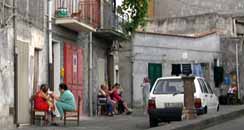Its narrow streets, courtyards, steps, paving in lava stone and the many testimonies left by the stone cutters of Bronte on the façades, in the portals, in the windows, still show unchanged the primitive buildings and the remains of the old country town. The more ancient districts are found in Via Santi, in the area Annunziata and Soccorso and around La Matrice church. In Corso Umberto ("a chiazza"), main road of the habitat and representative space of the local social life, you find the most important palaces including the prestigious Capizzi College.  In the center small streets, still adapted to an agricultural economy, and not, as yet, invested by the rhythm of industrial life, everything preserve an aspect by now unknown to city life. In the center small streets, still adapted to an agricultural economy, and not, as yet, invested by the rhythm of industrial life, everything preserve an aspect by now unknown to city life.
The family preserves part of the ancient power on his members, and, on everybody, is practiced the "incessant" protective vigilance of the neighborhood, to which is impossible to escape, but that does not impose such constraints to force the individuals to an outward behavior of acts and opinions. The ancient settlements, which conformed to the social structure with perfect adhesion, have been gradually submitted, since centuries, to the collision with industrial civilization.
Some of them could not stand this contact and disaggregated. | |
Their ancient balance was dispersed, but some ancient buildings with small streets and courtyards still subsist.
The ancient public spaces, however, that still answer eminently to collective purposes, are now somewhat different from those of a time.
|